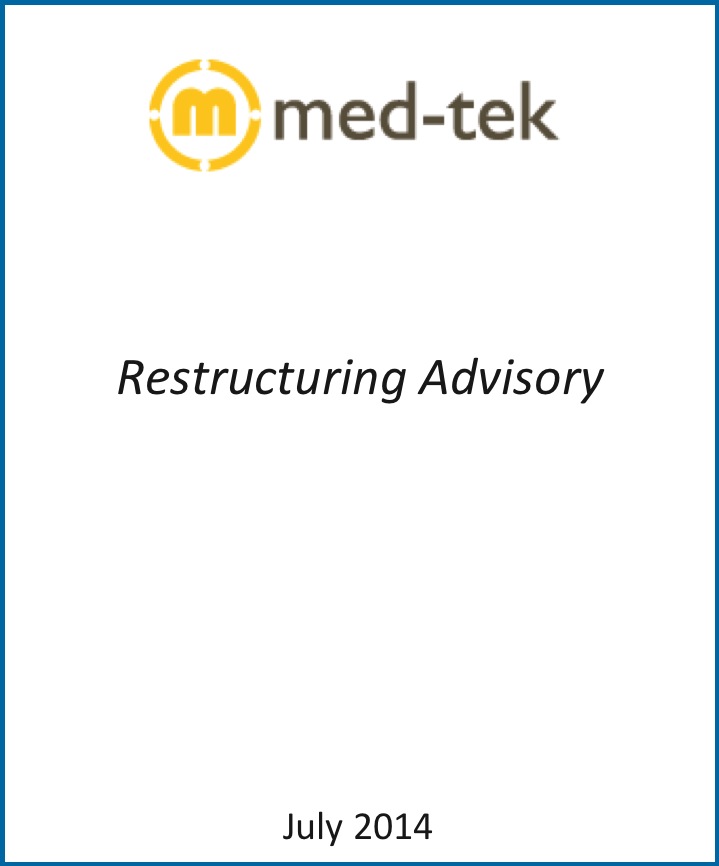Archive for year: 2014
New technologies propel middle-market business growth
To view the original article, click here.
By James Cassel
September 21, 2014
Technological innovations are enhancing the way that middle-market companies do business and creating significant opportunities for growth.
Recent data from Deloitte’s 2014 second-annual mid-market technology survey show that middle-market businesses are increasingly recognizing the pivotal role that technology can play. Cloud-based solutions and business analytics tools that provide “large corporation solutions” are credited for their ability to enhance operational capabilities, boost productivity, and provide competitive insights, according to the survey results. The continuing reductions in cost have made them more affordable to the middle market and have been a great catalyst in adoption rates.
Key survey findings include:
▪ 50% of the executives surveyed say their companies are currently using or migrating to cloud-based solutions
▪ 41% say their leadership now perceives technology as a “critical differentiator and key to growth,” and an additional 38 percent view it as “a strategic investment”
▪ 58% say their company is spending more or significantly more on technology in 2014, compared to 45% in 2013 (signs of a growing economy)
▪ 36% are allocating at least half of their IT budgets to new technology rather than maintaining current systems
▪ More companies are using data analytics to better understand their business metrics and to improve marketing to customers
A growing number of businesses – particularly those controlled by young entrepreneurs and startups – are leading the pack in embracing the new solutions and technologies. However, many businesses run by older individuals, who may not be as familiar or comfortable with some of these technologies or who might be more resistant to change, are still hesitating to adopt them. If you own a middle-market business, it would be wise to keep a close pulse on new technologies that will enhance your company’s profitability or output.
Accounting, for example, has been revolutionized by simple software. Everything from basic programs like QuickBooks to more complex enterprise-scale solutions means fewer labor hours, fewer mistakes, and more effective cash flow management and management reports.
Customer relationship management technologies such as SalesForce have made it easier to track, tag and manage contacts, leads, customers, vendors, and other relevant business relationships. Many of these platforms have opened up third-party application marketplaces to accommodate thousands of integrative technologies so businesses can manage and measure data from a plethora of sources.
Perhaps most noticeably, Web presence has been greatly enhanced, particularly for the middle market. Much more than the boring, pixelated internet brochures or online catalogues of yesteryear, websites are now capable of acting as central hubs for businesses’ information as well as e-commerce. It’s easier than ever to interface with customers, manage customer support, automated marketing, ordering, invoicing, shipping and much more.
I remember when a robust website could easily cost more than $10 million dollars. Today you can build that same website in a fraction of the time at a fraction of the cost.
Technological solutions for operational logistics have pushed productivity and efficiency to new heights as vendors like FedEx and UPS and even the US Postal Service offer systems to optimize global supply chains. These logistics also address hidden demons like customs, compliance and shipment monitoring.
Further, the device revolution has yielded an app for virtually everything. Medical professionals use tablets to chart notes and access patient records. Sales representatives and insurance agents can now process orders and claims in real-time. And processes including invoicing, security and marketing can be managed with the push of just a few buttons. I can even control my home air-conditioner from my iPhone, thanks to Nest.
Finally, scalable human resources and employee-management solutions like Paychex and ADP have freed business operators, enabling them to dedicate more time to running their businesses and spend fewer hours processing payroll, negotiating benefits packages, or investing in complicated customized HR dashboards.
But implementing technology to scale growth is not without its challenges and must be done strategically to ensure success and maximize return on investment with the least amount of interference. There are many technological solutions and vendors on the market, and it’s important to wade through the hype to determine what technologies will best support the needs of your business.
It’s no secret that technology, particularly web technology, carries the threat of security breaches. It seems that every week a new leak, hack or virus is plaguing businesses and creating crises of compromised – and sensitive – data.
Look at the recent problems of Target and Home Depot. According to the Deloitte survey, approximately one-third of respondents are concerned about the security of the data and services provided by cloud-based solutions. Clearly, no business needs a security scandal. Before you implement any solutions, conduct a thorough audit of what information you will be exposing to or through the technology, and what security you have in place.
Next, you should decide if you will use off-the-shelf solutions or a custom system built from the ground-up specifically for your business needs. Although custom solutions can be costly, it’s important to keep in mind that using solutions that do not entirely meet your needs could be costlier in the long run. The best solution may be an off-the-shelf solution that you customize to your specific needs.
Without a doubt, it is no small task to identify where and how you might benefit the most from these new solutions, or who the best providers would be for your particular needs. According to the Deloitte survey, 25% of executives agree it’s hard to keep up with the rapidly changing technology landscape.
Rather than trying to tackle something that might not be within your expertise, get advice from consultants who keep abreast of the latest innovations and have the knowledge and experience to assess your business needs. This can help ensure that you chart the best course for your business and put it in the strongest position for continued growth. Like most business initiatives, this takes a commitment of time, money and resources.
James Cassel is co-founder and chairman of Cassel Salpeter & Co., LLC, an investment-banking firm with headquarters in Miami that works with middle-market companies. www.casselsalpeter.com
James S. Cassel: The time to begin succession planning is now
To view the original article, click here.
By James S. Cassel
August 17, 2014

James S. Cassel
Death and taxes are not the only certainties in life: Like it or not, at some point, you will have to leave your business. Hopefully, you will do so when and how you want, and with the benefit of an appropriate succession plan to help ensure the best-possible outcome.
Although most people don’t dispute the benefits of succession plans, they don’t pay enough attention to this important aspect of business ownership. Most of us would love to think that we will leave our businesses when we are good and ready, but we must be prepared for unforeseen circumstances that may lead to our sudden departures. The trouble with unexpected events is that they occur unexpectedly. So, when is the right time to begin planning? Simply put: “Now.” In my experience, I have seen many businesses suffer serious consequences, including everything from divisive family feuds among potential heirs to dissolution of the businesses, simply because the owners had failed to develop the necessary succession plans with appropriate documentation.
Here are some key considerations and tips to help ensure you are on the right track. First, it’s important to think about how you would like to leave your business. Will you step away all at once, abruptly, or will you do so gradually, transitioning slowly? Part of your transition plan can include extracting yourself from the day-to-day logistics and moving to a more advisory or consulting role.
Among the many considerations when planning a succession, exit or transition in a business, you will have to ask yourself if and how your family will play a role going forward. First, are family members involved or do any want to be involved? Do they have the skills, experience, wherewithal and drive to be responsible stewards of the company’s interests and the family’s assets? Perhaps a family member who initially wasn’t interested in playing a role in the company becomes interested over time.
Consider the age of your successors. If you’re approaching retirement, anointing a sibling or near relative of comparable age may be counterintuitive, depending on your age. In that case, ask yourself how you will integrate the next generation into the business. In some cases, this can include bringing in a daughter-in-law or son-in-law. Another consideration to keep in mind is that sometimes the best successors are not family members but rather long-time employees. How all of this differs from bringing in blood relatives is ultimately up to you, but in any case it’s always wise to speak with qualified consultants to afford yourself certain protections and, above all, peace of mind.
Failure to establish a clear succession plan can cause complications later as familial involvement in the business expands. For example, I worked with two families that owned a business together. The grandfathers had started the business, and when their sons, the second generation, inherited the business, the company continued to grow and prosper and the successors got along great. However, the third generation did not get along professionally or personally. The combination of unsolvable issues cost them the entire business. Everything that everyone had worked so hard to build was eventually destroyed, and they lost it all.
Could this have been avoided? Absolutely, if the second generation had established a clear plan for familial succession with appropriate agreements and provisions in the event of problems.
Remember, though, that family members are not the only stakeholders you’ll have to consider when you’re planning your exit. If you went into business with a non-family partner, ask yourself how you will navigate the channels of exiting if you want to sell and your partner doesn’t. This is particularly problematic when business partners are of disparate ages.
The matter can become even more complicated with multiple partners. For instance, two of the three partners of a successful firm I know were ready to retire last year, but the third wanted to stay and continue building the business. It took months of planning and preparation and going back and forth, and ultimately the best they were able to manage was to allow one of the partners to retire while the other had to wait longer before exiting. The business simply couldn’t absorb the transition of two of three stakeholders at the same time from both an operational and financial sense.
Finally, we are always subject to the unexpected. Passing away without planning the succession of your business can be logistically disastrous for your company and financially stressful for your family and legal heirs. No matter your industry, number of stakeholders or types of stakeholders, your company’s longevity is best served by spending time planning for succession. This plan should be drafted with the guidance and input of experienced lawyers, accountants, insurance professionals as well as other appropriate consultants and should provide for the possibility of disability, in the event that you may not be able to participate in traditional operations. Sometimes selling the business is a better option.
Although planning for the inevitable is not always pleasant, the consequences of unforeseen events may be mitigated by thoughtful preparation. Similarly, the discomforts of retiring from a company you have run for years can be ameliorated by the knowledge that you are taking the right steps to protect your legacy.
James Cassel is co-founder and chairman of Cassel Salpeter & Co., LLC, an investment-banking firm with headquarters in Miami that works with middle-market companies. He can be reached at jcassel@casselsalpeter.com and www.casselsalpeter.com.
Practical tips for growing small businesses into middle-market businesses
To view the original article, click here.
By James S. Cassel
July 20, 2014

It’s a common question for small-business owners: “How can I take my company to the next level and become a middle-market business?” Although at Cassel Salpeter we focus on working with middle-market businesses, I often run into small-business owners in the community who ask for some practical tips.
I define the middle market as any business with $10 million to $250 million in enterprise value. Although there are more than 27 million businesses in the United States according to the last census, only about 300,000 have more than $5 million in revenues. So, becoming a middle-market business clearly is not easy. However, in many cases it may be attained with hard work and the right strategy (and a little luck does not hurt).
No matter how you position your business for growth into the middle market, you will have to prepare your business strategy.
First, evaluate the size of the market for your product or service and your position within the market. Is it saturated with competitors? Is it a stagnant market or are there growth prospects? Are you in a unique position to capitalize on growth opportunities? There’s more than one way to expand: you can expand organically by opening additional locations or by buying a competitor or similar business in your current market or a new market. You might market or advertise more or hire additional sales people.
When looking to grow, find out if there’s room for innovation with your products or services. Do you make standard nuts and bolts with little room for improvement, or can you innovate and expand your product line? It’s always great to survey your current and potential customers or clients and determine what would most interest them.
Furthermore, do you have adequate capital for growth? Again, you have multiple options. You can pursue a Small Business Administration loan or identify a Small Business Investment Company to provide a loan or invest in your organization. Alternatively, you can decrease your distributions and instead retain earnings to build up your equity base. You might get additional vendor financing. For the right plan, capital should be available.
Sometimes a simple policy change can help. Take inventory of your current policies and determine if they are aiding or impeding your growth. For example, online retailer Zappos instituted a 365-day return policy, a sharp departure from the then industry standard of 30 days. Zappos figured out that customers would feel more comfortable buying more items knowing they could return them without hassles. Although counter intuitive, its return rates actually dropped. This helped propel Zappos toward explosive growth.
Next, you’ll need to evaluate your distribution model and channels. Generally, the more distribution channels you have, the more opportunities you will have to move product. Before the advent of online shopping and commerce, brick and mortar stores were the primary means for purchasing goods along with catalogs. Remember the Sears catalog? Catalogs and mail order shopping expanded in popularity over time, vastly expanding the reach of businesses like Victoria’s Secret and other consumer and apparel outlets. But now there are a wide variety of multichannel distribution options. Potential consumers search for items, they receive emails and notifications about new products and specials, they walk past storefronts, and their friends share content about brands on social media channels. To maximize growth, make sure you are present and easily accessible wherever your customers and referral sources are, and keep a close pulse on which channels are working best for you and why.
Growing your business also means hiring and retaining the right talent. Turnover is costly; pay good people fairly and incentivize them to stay.
Finally, a primary external factor you will contend with is the economy. In a growing economy, retailers grow; in a slowing economy, those same retailers shrink. Ensure you have the capital and systems to weather a downturn so you can capitalize on the peaks. You must look at the trends as sometimes things shift, i.e. from the store to the web. Other external factors can play a role such as governmental regulation at the municipal, state, or federal levels, and a changing market. It is always a good idea to keep an eye on what your competitors are doing.
It’s important to have a sound business plan in place and update it several times a year to ensure you are on track for the goals you set for your business. Even if you are not ready to expand right now, conduct an evaluation and ask yourself how you would tackle each of your challenges. Identifying how you will overcome these standard growth obstacles early on will aid you in forming the long-term strategic thinking and planning you’ll need to propel your business to middle-market status. Moreover, it’s always a smart idea to consult qualified advisors with experience handling these issues who can help ensure that you are on the right path.
James Cassel is co-founder and chairman of Cassel Salpeter & Co., LLC, an investment-banking firm with headquarters in Miami that works with middle-market companies. He can be reached at jcassel@casselsalpeter.com and www.casselsalpeter.com
Cassel Salpeter & Co. represents DynaVox in section 363 sale
To view the original article, click here.
June 19, 2014
Cassel Salpeter & Co. represented DynaVox Inc., debtor-in-possession, in connection with a Section 363 sale transaction approved by the Delaware Bankruptcy Court to Tobii Technology AB, a Swedish technology company with offices worldwide. In a competitive auction on May 21, Tobii was the successful bidder for substantially all of the operating assets of DynaVox with its $18 million bid. The transaction closed on May 23.
Tobii expects the purchase of DynaVox to solidify the position of its assistive technology division as the international leader in the augmentative and alternative communication and accessibility markets. DynaVox, with headquarters in Pittsburgh, provides speech-generating devices and symbol-adapted special education software to help people overcome speech, language, and learning challenges.
Cassel Salpeter advised DynaVox in completing the sale in an expedited three-week time frame and provided assistance throughout all phases of the sales process, due diligence, and auction.
“We are pleased to have successfully represented our client in this complex sale in a tight timeframe,” said James Cassel, co-founder and chairman of Cassel Salpeter, who led the assignment along with Philip Cassel, an associate with the firm.
Added DynaVox’s bankruptcy counsel Paul J. Battista: “The sale was a great success in that it assures all creditors will be paid in full and money will be available to be distributed to shareholders. Jim and his team jumped into the process, came up to speed quickly and were invaluable in helping generate this great result.”
Tobii is noted as a global market leader in eye tracking and a pioneer in gaze interaction. Its products are widely used for communications by people with disabilities. They are also used within the scientific community and in commercial market research and usability studies.
The debtors were represented by Paul Battista and Heather Harmon, partners with Genovese Joblove & Battista, P.A., and William Chipman, Jr., partner, and Mark Olivere, counsel, with Cousins Chipman & Brown, LLP.
Cassel Salpeter & Co. is an independent investment banking firm that provides advice to middle-market and emerging growth companies in the U.S. and worldwide. Together, the firm’s professionals have more than 50 years of experience providing private and public companies with a broad spectrum of investment banking and financial advisory services, including: mergers and acquisitions; equity and debt capital raises; fairness and solvency opinions; valuations; and restructurings, such as 363 sales and plans of reorganization.
For older business owners, knowing when to sell the business is critical
To view the original article, click here.
By James S. Cassel
June 15, 2014
I was recently introduced to a successful entrepreneur business owner in his 90s who is considering selling one of his businesses. After our first meeting, his question became one that puzzles many older business owners: “Should I sell my business while I’m still alive  or let my family sell it after I’m gone?”
or let my family sell it after I’m gone?”
In the weeks following our meeting, he has continued to ponder this question, as he wants to make sure that his decision will be in the best interests of his family and the business.
His financial advisors are encouraging him to wait to sell until after he has passed away. What they are suggesting, which is not a novel concept, seems to make perfect financial and tax sense on paper. Their recommendation is based on the assumption that by waiting to sell after his death, his estate can enjoy significant tax benefits from a “step-up in basis” (a readjustment of the value of an asset when it is inherited).
In simple terms, here’s how this generally works: Let’s assume you own a $50 million business and your tax basis in it is $5 million. If you sell the business during your life for $50 million, you will pay capital gains tax on $45 million; after you pass away, your family will pay an estate tax on the net remaining monies.
However, if the business is sold after your death for $50 million, the basis is recalculated. Your heirs would pay the estate tax on the $50 million but wouldn’t owe any capital gains taxes. The logic here is that you are mathematically better off retaining your business and having it sold after your death to greatly reduce the amount of taxes due.
Here are some of the flaws in that line of thinking: His advisors are neglecting to take into consideration the fact that the value of the business might drop after the owner — who has been the heart and soul of the business for decades — is no longer part of the business’ daily operations. Indeed, business valuations tend to suffer after the individuals who were the primary business drivers die.
Moreover, the course of action recommended by his advisors would put the burden of selling the business on his wife and brother in his 80s, who might not be the best-qualified person to handle the process under the emotional duress that is likely to follow his death.
This business owner should consider other key issues, such as the effects of his passing on the employees, customers, lenders, management and suppliers, to name a few. For example, if customers become concerned about the future operation and stability of the business and decide to explore other suppliers, this decrease in business could adversely affect the business’s value. Even with ample preparation, this business owner would have very little control over how his death will affect the valuation, or how a divestiture would affect his family as well as the business.
What did this gentleman decide to do? The jury is still out, as he is still evaluating the options. One of the reasons he probably likes the suggestion of his advisors is that it would enable him to continue working in a business that has been part of his persona for more than 50 years. Like other business owners in his position, he might feel sentimentally attached to his business. The danger in sentimental attachment is that decisions are often made for emotional reasons and not based on what may be in the best interest of the company and its stakeholders.
Based on my experience helping business owners navigate these complex issues, I am confident that he and his family will be better off if he sold the business while he is still alive. During our meeting, I explained to him that there are a wide variety of alternatives to selling outright at this time, if he wishes to continue working at his business as long as possible. Finding a partner to whom he can sell part of the business now and then sell the remainder after he has died could make sense under the right circumstances for the business and his family.
Although finding an appropriate partner can be a challenge that requires help from qualified advisors, it can be well worth it in the long run. For example, this approach could ease some of his business tax burdens and create a clearer succession path for the business. The best alternative might, in fact, be to sell the business to a strategic buyer who might pay the maximum amount and put in place an employment agreement if the owner wants to remain involved.
Without a doubt, letting go of a business that you have owned and nurtured for years is no easy task. When it comes to finding the right time to sell, there are no cookie-cutter approaches or crystal balls. It is crucial to consult with qualified advisors, including investment bankers, who can provide the necessary strategic counsel and perspectives to help protect your best interest.
James Cassel is co-founder and chairman of Cassel Salpeter & Co., LLC, an investment-banking firm with headquarters in Miami that works with middle-market companies. He can be reached at jcassel@casselsalpeter.com and www.casselsalpeter.com
Cassel Salpeter & Co. Represents DynaVox in $18 Million Sale
MIAMI – June 12, 2014 – Cassel Salpeter & Co., a middle-market investment banking firm providing merger, acquisition, divestiture and corporate finance services, represented DynaVox Inc. (OTCPK: DVOX.Q), debtor-in-possession, in connection with a Section 363 sale transaction approved by the Delaware Bankruptcy Court to Tobii Technology AB, a Swedish technology company with offices worldwide. In a competitive auction on May 21, Tobii was the successful bidder for substantially all of the operating assets of DynaVox with its $18 million bid. The transaction closed on May 23.
Tobii expects the purchase of DynaVox to solidify the position of its assistive technology division as the international leader in the augmentative and alternative communication and accessibility markets. DynaVox, with headquarters in Pittsburgh, provides speech-generating devices and symbol-adapted special education software to help people overcome speech, language, and learning challenges.
Cassel Salpeter advised DynaVox in completing the sale in an expedited three-week time frame and provided assistance throughout all phases of the sales process, due diligence, and auction.
“We are pleased to have successfully represented our client in this complex sale in a tight timeframe,” said James Cassel, co-founder and chairman of Cassel Salpeter, who led the assignment along with Philip Cassel, an associate with the firm.
Added DynaVox’s bankruptcy counsel Paul J. Battista: “The sale was a great success in that it assures all creditors will be paid in full and money will be available to be distributed to shareholders. Jim and his team jumped into the process, came up to speed quickly and were invaluable in helping generate this great result.”
Tobii is noted as a global market leader in eye tracking and a pioneer in gaze interaction. Its products are widely used for communications by people with disabilities. They are also used within the scientific community and in commercial market research and usability studies.
The debtors were represented by Paul Battista and Heather Harmon, partners with Genovese Joblove & Battista, P.A., and William Chipman, Jr., partner, and Mark Olivere, counsel, with Cousins Chipman & Brown, LLP.
About Cassel Salpeter & Co.
Cassel Salpeter & Co. is an independent investment banking firm that provides advice to middle market and emerging growth companies in the U.S. and worldwide. Together, the firm’s professionals have more than 50 years of experience providing private and public companies with a broad spectrum of investment banking and financial advisory services, including: mergers and acquisitions; equity and debt capital raises; fairness and solvency opinions; valuations; and restructurings, such as 363 sales and plans of reorganization. Co-founded by James Cassel and Scott Salpeter, the firm provides objective, unbiased, results-focused services that clients need to achieve their goals. Personally involved at every stage of all engagements, the firm’s senior partners have forged relationships and completed hundreds of transactions and assignments nationwide. The firm’s headquarters are in Miami. Member FINRA and SIPC.

Get In Touch
Cassel Salpeter & Co.
801 Brickell Avenue,
Suite 1900
Miami, FL 33131
(305) 438-7700
Stay Informed
Sign up today for insights and growth strategies.
Subscribe Now








